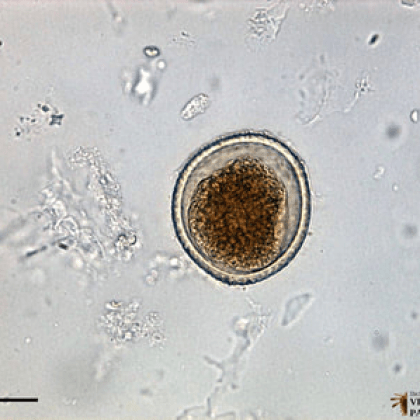Knowledge gaps in the epidemiology of Toxocara: the enigma remains
The latest Parasitology Paper of the Month is “Knowledge gaps in the epidemiology of Toxocara: the enigma remains” by Celia Holland.
Some parasites seem to have a Cinderella status. Down in the basement of the ugly stepmother’s house, they are working away, busily infecting many hosts but there is no handsome prince, in the form of generous research funding, to bring them to the ball. Despite the most welcome initiatives concerning Neglected Tropical Diseases (NTDs), human toxocariasis, with its worldwide distribution, remains strangely ignored. Why is this so? There is no doubt that its multiple routes of transmission to hosts, both domestic and feral, its cryptic disease picture in humans, problems with diagnosis and treatment and its widespread environmental contamination, all contribute to the challenge of researching this enigmatic helminth and to devising appropriate preventative and control measures.
However, that is not the full story. The number of investigators who make Toxocara their main focus is diminishing. Tragically, Huw Smith, of the Scottish Parasite Diagnostic Laboratory, passed away and several other leading figures, such as J-F Magnaval and Mervyn Taylor, have retired. We now need young, able scientists to contribute to the challenge. However, Peter Hotez remains a passionate advocate, raising awareness of Toxocara. He recently included the parasite in a ‘Viewpoint’ for JAMA Psychiatry, focusing on five infections affecting the American brain. From the veterinary perspective, Dwight Bowman and Paul Overgaauw are equally passionate in educating veterinarians about the zoonotic potential of Toxocara.
This is the background to my paper “Knowledge gaps in the epidemiology of Toxocara: the enigma remains”, a contribution to the One Health special issue in Parasitology and the BSP symposium. The enigma refers to the title of the book, Toxocara the enigmatic parasite, edited by Huw Smith and I back in 2006. We have made some progress since then. But, as outlined in my paper, there remain at least nine gaps in our knowledge, gaps that seem shocking when we contrast them with our knowledge of other major human parasites. For example, it seems inconceivable that we do not know what species of Toxocara contributes most to human exposure, Toxocara canis or T. cati and still lack information on the precise relationship between exposure and disease.
As outlined in the paper, what we urgently require is a One Health approach to the study of Toxocara and toxocariasis. I suggest an ideal scenario initially involving a single country or defined region, in which sources of infection in humans, other animals and the environment are comprehensively assessed. The relationship between seropositivity in humans and the extent of significant disease is also explored, as is the detection of eggs in the environment and larvae in paratenic hosts. The collection of such crucial baseline epidemiological data would provide the basis for an intervention study encompassing anthelmintic treatment and anti-fouling, with subsequent follow up. There is no doubt that such an approach would be logistically challenging and costly. But, for the first time, it would place Toxocara in a One Health context, and provide a framework for future prevention and control. Now is the time for major pharmaceutical companies, for whom veterinary anthelmintics is a lucrative line of production and sale, to join with the research community, by funding a significant One Health programme of research focused upon Toxocara.
Read the full article “Knowledge gaps in the epidemiology of Toxocara: the enigma remains” in full for free until 28th February 2017.






